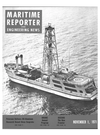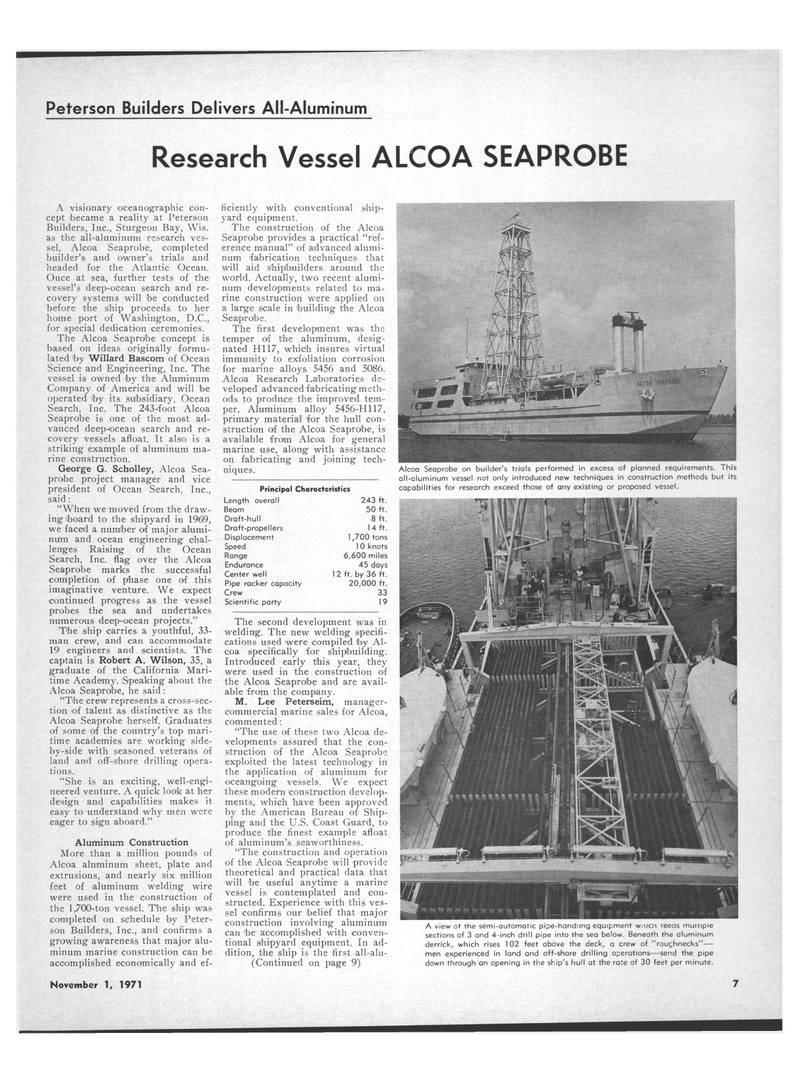
Page 5: of Maritime Reporter Magazine (November 1971)
Read this page in Pdf, Flash or Html5 edition of November 1971 Maritime Reporter Magazine
Peterson Builders Delivers All-Aluminum
Research Vessel ALCOA SEAPROBE
A visionary oceanographic con- cept became a reality at Peterson
Builders, Inc., Sturgeon Bay, Wis. as the all-aluminu'm research ves- sel, Alcoa Seaprobe, completed builder's and owner's trials and headed for the Atlantic Ocean.
Once at sea, further tests of the vessel's deep-ocean search and re- covery systems will be conducted before the ship proceeds to her home port of Washington, D.C., for special dedication ceremonies.
The Alcoa Seaprobe concept is based on ideas originally formu- lated 'by Willard Bascom of Ocean
Science and Engineering, Inc. The vessel is owned by the Aluminum
Company of America and will be operated iby its subsidiary, Ocean
Search, Inc. The 243Jfoot Alcoa
Seaprobe is one of the most ad- vanced deep-ocean search and re- covery vessels afloat. It also is a striking example of aluminum ma- rine construction.
George G. Scholley, Alcoa Sea- probe project manager and vice president of Ocean Search, Inc., said: "When we moved from the draw- ing iboard to the shipyard in 1969, we faced a number of major alumi- num and ocean engineering chal- lenges Raising of the Ocean
Search, Inc. flag over the Alcoa
Seaprobe marks the successful completion of phase one of this imaginative venture. We expect continued progress as the vessel probes the sea and undertakes numerous deep-ocean projects."
The ship carries a youthful, 33- man crew, and can accommodate 19 engineers and scientists. The captain is Robert A. Wilson, 35, a graduate of the California Mari- time Academy. Speaking about the
Alcoa Seaproibe, he said : "The crew represents a cross-sec- tion 'of talent as distinctive as the
Alcoa Seaprobe herself. Graduates of some of the country's top mari- time academies are working side- by-side with seasoned veterans of land and off-shore drilling opera- tions. "She is an exciting, well-engi- neered venture. A quick look at her design and capabilities makes it easy to understand why men were eager to sign aboard."
Aluminum Construction
More than a million pounds of
Alcoa aluminum sheet, plate and extrusions, and nearly six million feet of aluminutn welding wire were used in the construction of the 1,700-ton vessel. The ship was completed on schedule by Peter- son Builders, Inc., and confirms a growing awareness that major alu- minum marine construction can be accomplished economically and ef- ficiently with conventional ship- yard equipment.
The construction of the Alcoa
Seaprobe provides a practical "ref- erence manual" of advanced alumi- num fabrication techniques that will aid shipbuilders around the world. Actually, two recent alumi- num developments related to ma- rine construction were applied on a large scale in building the Alcoa
Seaprobe.
The first development was the temper of the aluminum, desig- nated HI 17, which insures virtual immunity to exfoliation corrosion for marine alloys 5456 and 5086.
Alcoa Research Laboratories de- veloped advanced fabricating meth- ods to produce the improved tem- per. Aluminum alloy 5456-H117, primary material for the hull con- struction of the Alcoa Seaprobe, is available from Alcoa for general marine use, along with assistance on fabricating and joining tech- niques.
Principal Characteristics
Length overall
Beam
Draft-hull
Draft-propellers
Displacement
Speed
Range
Endurance
Center well
Pipe racker capacity
Crew
Scientific party
Alcoa Seaprobe on builder's trials performed in excess of planned requirements. This all-aluminum vessel not only introduced new techniques in construction methods but its capabilities for research exceed those of any existing or proposed vessel. 243 ft. 50 ft. 8 ft. 14 ft. 1,700 tons 1 0 knots 6,600 miles 45 days 12 ft. by 36 ft. 20,000 ft. 33 19
The second development was in welding. The new welding specifi- cations used were compiled by Al- coa specifically for shipbuilding.
Introduced early this year, they were used in the construction of the Alcoa Seaprobe and are avail- able from the company.
M. Lee Peterseim, manager- commercial marine sales for Alcoa, commented: "The use of these two Alcoa de- velopments assured that the con- struction of the Alcoa Seaprobe exploited the latest technology in the application of aluminum for oceangoing vessels. We expect these modern construction develop- ments, which have been approved by the American Bureau of Ship- ping and the U.S. Coast Guard, to produce the finest example afloat of aluminum's seaworthiness. "The construction and operation of the Alcoa SeaprObe will provide theoretical and practical data that will be useful anytime a marine vessel is contemplated and con- structed. Experience with this ves- sel confirms our belief that major construction involving aluminum can be accomplished with conven- tional shipyard equipment. In ad- dition, the ship is the first all-alu- (Continued on page 9)
A view ot the semi-automatic pipe-handling equipment wnicn leeas multiple sections of 3 and 4-inch drill pipe into the sea below. Beneath the aluminum derrick, which rises 102 feet above the deck, a crew of "roughnecks"— men experienced in land and off-shore drilling operations—send the pipe down through an opening in the ship's hull at the rate of 30 feet per minute.
November 1, 1971 7

 4
4

 6
6
